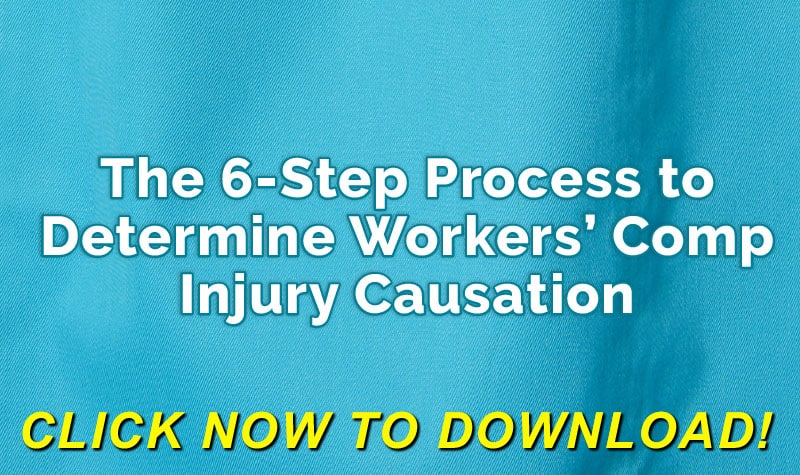
The cannabis industry is growing by leaps and bounds and shows no signs of slowing. Most states now allow the drug in some form. Judges are increasingly siding with injured workers who want to be reimbursed for the drug.
Employers, especially those who do business in multiple states, need to know how to ensure a safe workplace, be fair to all employees and protect themselves from litigation. Staying abreast of the latest developments is key.
Click Link to Access Free PDF Download
“The 6-Step Process To Determine Workers’ Comp Injury Causation”
Some Basics
Terminology. Keeping up with the lingo can be exhausting, but payers who do have an edge when it comes to addressing the issue. Some important terms include:
- THC: A cannabinoid that produces the ‘high’ that users experience
- CBD: A molecule touted as having potential medical benefits without the psychoactive properties of THC.
- Hemp: A strain derived from the species cannabis sativa, as is marijuana, but with lower concentrations of THC and more CBD. The Agricultural Improvement Act signed into law recently removed hemp from the list of Schedule I controlled substances and made it an ordinary agricultural commodity. CBD derived from hemp has recently become widely available.
- Strains: There are hundreds of combinations, mainly from three strains:
- Indica — produces a more relaxing effect
- Sativa — is more energizing
- Ruderalis — has low levels of both THC and CBD.
- Budtender: The person at a ‘dispensary’ who gives advice about which varieties may be more helpful to the user
Physical Effects
Whether and to what extent marijuana helps with various physical or mental conditions is a matter of debate, since the federal prohibition of the drug stymies research on it. But there is some evidence it may help alleviate chronic and neuropathic pain, cancer pain, and spasticity. Some people claim it can also help with anxiety, post-traumatic stress disorder, traumatic brain injury, depression or acute pain. There are conflicting studies about whether marijuana can serve as a viable substitute for opioids, but the most recent study suggests it does not.
High doses of marijuana, especially when it’s ingested as an edible, can have serious repercussions. Some users have gone to emergency rooms believing they are having a heart attack. In addition to the potentially positive impacts, the drug can also cause a variety of unpleasant symptoms, including:
- Rapid, irregular heart rate
- Anxiety
- Lung irritation
- Coughing, wheezing
- Nausea, vomiting
- Various exacerbations of serious psychiatric conditions such as depressions, bipolar illness, schizophrenia and other psychotic disorders.
Problems for Employers, Payers
Drug testing to identify marijuana users high on the job may be counterproductive. Since the drug stays in the body long after its effects have worn off, the tests can’t really determine if a person is impaired. Workers in safety-sensitive jobs are another story, as they are prohibited from performing their jobs if there is any sign of drug use identified.
However, for other workers, employers may notice certain signs that could indicate an employee is under the effects of marijuana:
- Slowed responses and reflexes
- Lethargy, drowsiness
- Slowed perception of time; appearing in an almost dreamlike state
- Unfocused
- Impaired memory function
- Red eyes or dilated pupils
Employers who suspect their workers of being high on the job must be careful about how they respond. Unless they have clear-cut policies that allow for drug testing when they suspect impairment, organizations can be accused of discriminating against certain employees. Working with an attorney and developing a solid policy that is communicated to all employees is imperative.
Another major concern for payers concerns the logistics for reimbursement. It’s not like other, FDA-approved drugs, where a physician prescribes a certain dose, number of pills per day and timeframe for use. Physicians in medical marijuana states can only recommend using the drug. It’s then up to the user, working with the budtender, to determine what might help.
The many different strains mean one purchase may be different from another. There are many inconsistencies in terms of the quality and purity as well as labeling — within states and even within communities.
However, as the pharmaceutical companies begin to derive purer and more targeted compounds from marijuana, we will likely see more employees using prescribed, rather than marijuana dispensary, formats which will reduce the rationale for using the latter, and will provide safer, efficacious and accurately dosed drugs.
The best advice from experts is to work closely with all stakeholders involved including the injured worker, and leverage the expertise of your pharmacy benefits management company. Having your PBM work with the treating physician, for example, might persuade her to prescribe a treatment or medication other than marijuana. At the very least, it could help determine how much and for how long the drug will be used. Having more and better communication with the injured worker can provide insight into whether and why he believes marijuana is the best option and help determine the anticipated expense.
Conclusion
The issue of medical marijuana is not an easy one for workers’ compensation stakeholders right now, but it should not be ignored. Regardless of personal feelings about the issue, organizations are increasingly being forced to deal with it. Those who understand their states’ laws and the various nuances involved, and work with other stakeholders will be best prepared when it arises.

Contact: mstack@reduceyourworkerscomp.com.
Workers’ Comp Roundup Blog: https://blog.reduceyourworkerscomp.com/
©2019 Amaxx LLC. All rights reserved under International Copyright Law.
Do not use this information without independent verification. All state laws vary. You should consult with your insurance broker, attorney, or qualified professional.






